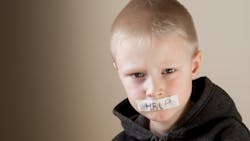How to report the unthinkable—child sexual abuse
COVID and quarantine have brought on the unforeseen risk for child abuse and neglect because many children are home with their parents or caretakers for very long stretches of time. In the meantime, recent events have cast a light on sexual abuses of both adults and children. Dental health-care providers can use these trends to address the issues as well.
Definition of child sexual abuse
All states have some definition of child abuse. Some are in general terms, while others include words such as “human trafficking,” “sex trafficking,” and “the production of child pornography.”1 There is currently no set definition that makes it difficult for states to prosecute and provide victims with the resources they need. The World Health Organization (WHO) defines sexual abuse as, “the involvement of a child in sexual activity that he or she does not fully comprehend, is unable to give informed consent to, or for which the child is not developmentally prepared, or that violates the laws or social taboos of society.”2
Related reading
Identifying and responding to child abuse and neglect
Mandated reporting: While emotionally draining to report abuse of children, it still must be done
Who’s at risk?
Any child aged 18 and under can be a victim of child sexual abuse. It does not discriminate due to age, race, religion, or socioeconomic status. According to Child Welfare Information Gateway, “80% of victims had been seen by health-care providers such as a medical doctor or dentist.”1
Oral signs of abuse
The most common child abuse injuries involve the head, neck, and mouth. Studies have shown that child abuse injury in these areas comprise up to 75% of cases.3 Head, neck, and oral-facial trauma give the dental team clues about what might be occurring at home. Avulsion of teeth due to abusive trauma is limited almost exclusively to the anterior teeth.
Other signs that should raise red flags include displacement, tooth fractures, laceration of the frenum, soft tissue injuries, palatal trauma, and oral signs of sexually transmitted diseases (STDs). Lacerations to the frenum in infants who do not yet walk are often signs of abuse.4 Wyckoff states, “Gags applied to the mouth may leave bruises or scarring at the corners of the mouth.” 4 Visible petechiae on the palate of a minor may be due to forced oral sex.
Dental hygienists are on the front line of patient providers and gather all assessment data during patient visits. It’s important to recognize, record, and report any suspicion of child abuse and neglect to the proper authorities. Photos are an appropriate way to document visible areas of trauma.
It is mandatory to report
State and federal legislation established in the 1970s created child protective services (CPS) agencies. New laws mandated that physicians and other professionals report suspected abuse to CPS.3 The Federal Child Abuse Prevention and Treatment Act (CAPTA) requires each state to have provisions and procedures for licensed health-care professionals to report any known or suspected instances of child abuse and neglect to the state protective services child abuse hotline.3 This includes dental hygienists because we are licensed in our states. Therefore, it is our professional obligation to become familiar with our state laws and regulations.
The state regulates abuse reporting requirements, but these may not be incorporated into the state dental practice act.5 Dental hygienists have an ethical responsibility to report any suspicion of child abuse to authorities, such as CPS. Many dental health providers want to pass this responsibility to the doctor, but dental hygienists must also report it. It is not, however, our responsibility to investigate a case. Also, reporters are not required to disclose their identity.
It is against many state laws for an employer to prohibit or retaliate against an employee who makes a report. Dental hygienists must also keep in mind that because we are legally mandated to report, we can be held legally liable if oral trauma is present and sexual abuse of a minor is suspected but not reported.3
Reporting child abuse
Collaboration between health-care and dental professionals is key to helping prevent, detect, and report cases. Dental hygienists need to know how to document suspicious injuries and file a report. Most states provide civil and criminal immunity to those who report in good faith, and parental consent is not needed to file a report.
Despite very little data from states regarding dental hygienists as mandatory reporters (no state CPS agency tracks the number of RDHs who report), potential penalties for not reporting include a malpractice suit, licensing fines, disciplinary action, license revocation, and criminal action.3
Long-term effects of child sexual abuse
Sexual abuse does not always leave visible scars. The trauma associated with such a traumatic and life-altering experience can manifest throughout the victim’s life. Children who report sexual abuse are at an increased risk for distress and mental disorders.3 When a child is constantly in fight-or-flight mode, the body will shut off anything it does not need to survive.
Such a system includes the anterior pituitary gland (APG), which is responsible for releasing the hormone somatotropin, the human growth hormone (GH). Growth hormone is vital for average physical growth in children. A lack of GH during a pivotal change can present itself as delayed growth of the central body systems. Long-term effects include delayed development, PTSD, depression, anxiety, substance abuse, eating disorders, suicidal behaviors, and high rates of comorbidity.3
Reporting can save a life
Making that phone call can seem daunting, especially if your colleagues and employer are telling you it’s not necessary. As professionals who work with the public, it’s essential to be aware that the children you’re providing care for today are tomorrow’s adults. You can profoundly impact their lives, and sometimes even save a life.
References
- Child Welfare Information Gateway. Definitions of child abuse and neglect. Department of Health and Human Services. 2019. https://www.childwelfare.gov/pubPDFs/define.pdf
- Butchart A, Harvey AP. Preventing child maltreatment: a guide to taking action and generating evidence. 2006. World Health Organization and International Society for Prevention of Child Abuse and Neglect. http://apps.who.int/iris/bitstream/handle/10665/43499/9241594365_eng.pdf?sequence=1
- Giardino A, Alexander R. Child maltreatment a clinical guide and reference, 3rd edition.W. Medical Publishing Inc. 2005.
- Wyckoff AS. When oral injuries lead to suspicion of abuse and neglect. American Academy of Pediatrics. 2017. http://bit.ly/2t97FjJ
- Beemsterboer P. Ethics and law in dental hygiene, 3rd edition. 2017. Elsevier Inc.
About the Author

Griselda Lopez, BSDH, RDH, CDA, FADHA
Griselda Lopez, BSDH, RDH, CDA, FADHA, is a dedicated dental hygiene professional with a passion for mentoring and training the future generation of dental professionals. Griselda is a member of the American Dental Hygienists’ Association (ADHA). She gives back to the community by volunteering at dental events. Contact her at [email protected].
